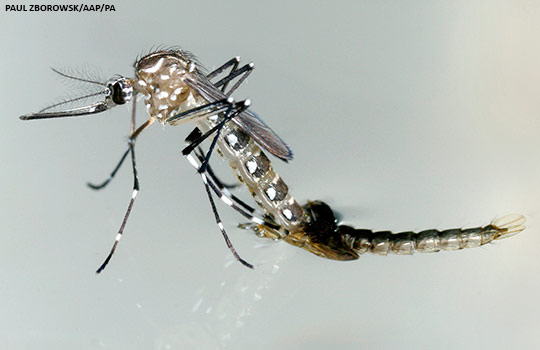
 Dengue fever was first detected in Sri Lanka in 1962. Although cases were initially sporadic, dengue has reached epidemic proportions during the past 15 years. Dengue fever used to show a clear seasonal pattern, with two incidence peaks during the northeast and southwest monsoon periods. However, patients with dengue fever are now seen throughout the year and the geographic spread also extends across the country except for small areas in the central hills.
Dengue fever was first detected in Sri Lanka in 1962. Although cases were initially sporadic, dengue has reached epidemic proportions during the past 15 years. Dengue fever used to show a clear seasonal pattern, with two incidence peaks during the northeast and southwest monsoon periods. However, patients with dengue fever are now seen throughout the year and the geographic spread also extends across the country except for small areas in the central hills.
In 2016 there were 55 150 reported cases [1]. Yet the number of cases has increased rapidly in the first seven months of 2017 (80 732 cases), already exceeding the total number in 2016. The number of deaths (215 in 2017) has also increased at an alarming rate [2].
Health facilities in the country are currently finding it difficult to deal with the increasing number of patients seeking care. Sri Lanka has a free of charge, government owned health system that covers over 90% of the country’s inpatients and around 50% of outpatients. At present, many major state hospitals have had to change the admission criteria for patients with dengue fever due to the increased demand. Only patients with evidence of impending plasma leakage, which can be life threatening, are now being admitted. In addition, private hospitals have also restricted the admission of patients with dengue due to a lack of facilities and space [3,4]. The country has not experienced an epidemic of this magnitude in many recent years.
At a time when Sri Lanka has been able to reduce the burden of many infectious diseases, including the elimination of malaria, and has achieved high vaccine coverage across the country for preventable communicable diseases, the emergence of yet another vector borne disease poses a major threat to the health of the population. The present situation raises many questions and one pertinent one is the effectiveness of the preventive strategies being employed to control dengue fever.
A huge proportion of the Sri Lankan health budget is diverted to dengue related expenditure for both curative and preventive programmes. Yet despite allocating funds, developing control strategies [5], enacting new legislation [6], and deploying health staff in preventive activities, the burden of disease due to dengue fever during the past 10 years has increased [7]. This points to a failure of the preventive strategies that the country has adopted.
The health authorities have resorted to crisis management at the peak of the epidemic each year rather than working on medium and long term objectives for controlling the disease. The spread of the epidemic is so intense that at present the reduction of adult mosquito density through chemical methods—mainly “outdoor fogging”—has become the main strategy. Fogging is a chemical control method that is used to augment source reduction whenever vector densities are high. However, fogging alone has not been able to contain the epidemic.
Lowering the threshold for fogging has resulted in the widespread use of fogging as the main mosquito control activity. The decision to initiate fogging is generally based on the Breteau Index (number of containers positive for mosquito larvae per 100 houses inspected) and is taken with caution when the index is low (less than 5), even if patients with dengue fever are in a locality [8,9]. However, at present fogging is initiated even if a single serologically confirmed or clinically diagnosed patient is found in an area.
This has resulted in a false assurance in the minds of the general public that fogging can prevent dengue, which makes them less likely to become involved in prevention activities. A reduced awareness of the inherent limitations of using chemical methods to control vector born disease, along with a false image created in the minds of the public on fogging, further weakens the implementation of other key control measures.
Efforts, for example, to engage the general public in preserving a clean environment have lost momentum. We’re now in the grave situation of the health authorities, with the help of local government institutes, having to take care of all aspects of garbage collection and household inspection for mosquito breeding sites. Unfortunately, the message that citizens have responsibility for the safe disposal of rubbish and for maintaining a clean household environment to reduce mosquito breeding grounds is not getting through. This approach is counterproductive and cannot be sustained with limited resources.
Given the limited impact of the country’s current dengue prevention programmes, Sri Lanka is in need of a constructive dialogue to identify the most effective strategies that can be implemented at field level to combat the spread of dengue. Sri Lanka urgently needs a fresh review of the current strategies, gaps in implementation, and failures in decision making. Developing effective medium and long term strategies, while containing the current epidemic, will be crucial if the country is to get the dengue epidemic under control over the long term.
Manuj C Weerasinghe is a senior lecturer and current head in the Department of Community Medicine, Faculty of Medicine, University of Colombo, Sri Lanka.
Sinha De Silva is a postgraduate trainee in the Department of Community Medicine, Faculty of Medicine, University of Colombo, Sri Lanka.
Competing interests: The authors declare no competing interests.
References
- National Dengue Control Unit, Sri Lanka (2017). Sri Lankan Situation. [online] Available at: http://www.dengue.health.gov.lk/index.php/information-on-dengue/sri-lankan-situation
- World Health Organization. (2017). Dengue fever – Sri Lanka. [online] Available at: http://www.who.int/csr/don/19-july-2017-dengue-sri-lanka/en/
- Epidemiology Unit, Sri Lanka (2017) Epidemiology Unit. [online] Available at: http://www.epid.gov.lk/web/images/pdf/Fact_Sheet/fact_sheet_on_dengue_for_primary_care_doctors.pdf
- Epidemiology Unit, Sri Lanka (2017) Epidemiology Unit. [online] Available at: http://www.epid.gov.lk/web/images/pdf/DHF/Message/opd_triage_on_dengue_final.pdf
- Ministry of Health. (2011). Strategic plan for prevention and control of dengue fever/dengue haemorrhagic fever in Sri Lanka 2011-2015: National Dengue Control Unit
- Citizens Lanka. (2017). PREVENTION OF MOSQUITO BREEDING ACT, NO. 11 OF 2007 – Citizens Lanka. [online] Available at: http://citizenslanka.org/acts/prevention-of-mosquito-breeding-act-no-11-of-2007/
- Epidemiology Unit, Sri Lanka (2017). Trends. [online] Available at: http://www.epid.gov.lk/web/index.php?option=com_casesanddeaths&Itemid=448&lang=en#
- Epidemiology unit, Sri Lanka (2017). [online] Available at: http://www.epid.gov.lk/web/attachments/article/188/Vol%2039%20NO%2003%20English.pdf
- Guideline for interpretation of data from vector surveillance and chemical vector control activities. (2009). Prepared by Anti Malaria Campaign Directorate in consultation with Entomological Division MRI & Western Provincial Council.
